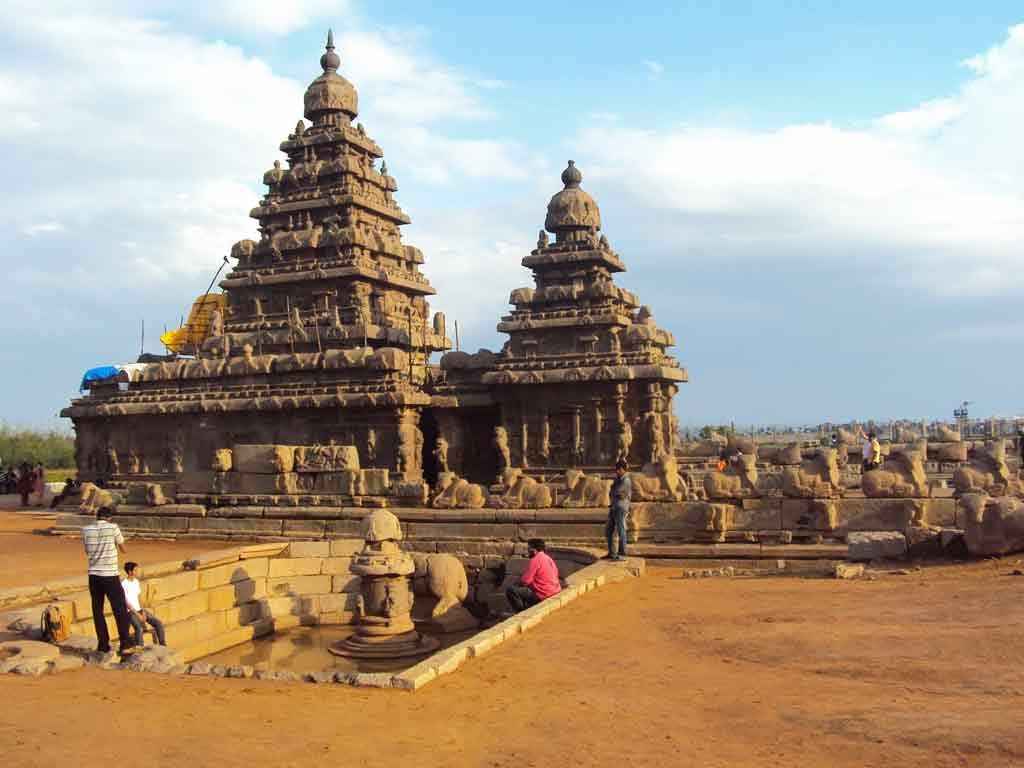The origin of the Pallavas remains obscure. The early kings of the race are said to have ruled from Kanchipuram as their political headquarters. They extended their territories as far as the Northern part of Andhra.
In the South, the Pallava Kingdom extended as far as the river Kaveri. The Prakrit copper plates, assignable on Paleographic grounds to the period 250-350 A.D., mention the names of Pallava kings who probably ruled about the beginning of the fourth century A.D.
Historian V.A. Smith presented a balanced view regarding the origin of the Pallava.

Image Source: d1bvpoagx8hqbg.cloudfront.net/originals/the-rock-temple-complex-of-pallavas-2325d2f96420c9e056f00fe5bbd18abc.jpg
ADVERTISEMENTS:
According to him, “It is possible that the pallavas were not one distinct tribe or class but a mixed population composed partly of foreigners and partly of South Indian tribes or castes, different in race from the Tamils and taking their name from the title of an intruding foreign dynasty which obtained control over them and welded them into an aggressive political power.”
Shivaskandavarman was perhaps the greatest among the early Pallava rulers, who ruled probably in the beginning of the fourth century A.D. The Pallava rulers ruled over the modern Andhra Pradesh and Karnataka. The contemporary Gangas and Kadamba rulers acknowledged the suzerainty of Pallavas.
The growth and development of Pallava history becomes more definite from the second half of sixth century A.D. One ruler Simhavarman ascended the throne in 575 A.D. He was a Buddhist. He defeated his contemporary Tamil ruler. Ceylon was also included in his kingdom. Mahendravarman (600-630 AD), the successor of Simhavarman, was a great ruler. He was also a poet, musician and builder of temples.
He was the author of the Vichitrachita. It was a highly imaginative literature of ancient times. The Mahavilasa prahasana was another title of Mahendravarman. He introduced the rock cut temple architecture. Mahendravarman was initially a Jain but later on was converted to Saivism. Mahedravarman fought against the ambitions Chalukya ruler Pulakesin II. The Aihole inscription gives a vivid picture of the conflict between the Chalukyas and the Pallavas which lasted for generations. Narasimhavarman Mahamalla (630-668 AD) was the successor of Mahendravarman. He was the greatest of the Pallava rulers. It was during his reign about 640 A.D. that Hiuen Tsang visited the Pallava kingdom. He gives an interesting description of Pallavas and their people.
ADVERTISEMENTS:
According to him there were several monasteries and Buddhist temples. People were living happily. There was an abundance of agricultural products. Narasimhavarman successfully sent a naval expedition to Ceylon to reinstate the Sinhalese prince Manavarma. He beautified the’ port of Mahamallpuram (Mahabalipuram). He conquered Vatapi, the Chalukyan capital in 642 AD.
Mahendravarman II succeeded to the throne after Narasimhavarman, and ruled from 668 TO 670 A.D. He was succeeded by his son Parameswaravarman. He ruled from 670 to 695 A.D. During his reign, the Pallavas got a setback from the Chalukyas. The Pallava capital Kanchi was occupied by the Chalukyas. Parameswaravarman was succeeded by his son Narasimhavarman. He was a follower of Siva, Dandini, the famous Sanskrit scholar was his court poet. The next important ruler of the dynasty was Nandivarman/Pallavamalla (730-800 AD). He fought against Pandyas and Rastrakutas.
The Pallava-Chalukya conflict also again started during his reign. He was a devotee of Vishnu and built Mukteswar Vaikanthaperumal temples at Kanchi. He was a scholar who patronised learning. Tirumangal Alvar, the famous saint flourished during Nandivarman. Dantivarman succeeded his father Nandivarman. The later Pallavas declined and lived as mere feudatory nobles.
Life under the Pallavas:
ADVERTISEMENTS:
The social structure under the Pallavas was based on Aryan culture. The Dharmasutras were recognised as althoritative texts. A large number of inscriptions of the Pallavas refer to their contribution to different aspects of culture. The Pallavas were orthodox Hindus. Most of them were the followers of Lord Vishnu and Siva. The University of Kanchi played an important role for the propagation of Aryan culture. Vatsyayana, the famous scholar who flourished during the Pallavas, was an Acharya of Kanchi University.
The literary development during the Pallavas was remarkable. The Pallava kings patronised scholars and learning. The Vaishnava and Saiva literatures developed during this age. The classic “literatures of Sanskrit and Tamil were given royal patronage. Dandini and Vastyayana, the two erudite scholars, were flourishing during the Pallavas. The Pallava king Mahendravarman wrote Mattavilas in Sanskrit.
Pallava rulers were great patrons of art and architecture. The Pallava style of art and architecture varied with the taste of the rulers. The Pallava architectural style consists of Mahendra style (600-625 AD), Mammala styles (625-674 AD), Rajasimha and Nadivarman style (674-800 AD); and Aparjita style of early ninth century. The Pallava rulers were great builders of temples. King Mahendra Patronised the Jaina Shrines and rock cut temples. The famous Kailashnath temple of Kanchi was built by Narasimhaverman II.
The Mukteswar temple, Matungeswar temple and Vedamalliswara temples at Kanchi belong to the Pallava period. Mahendravarman 1 laid the foundation of Mahavalipuram, the birth place of South Indian architecture and structure. Narasinhavarman gave a fresh touch to Mahavalipuram. He constructed a number of shrines and rock cut temples dedicated to Vaishnavism. There was a regular evolution of Pallava art and architecture of different style in different ways.